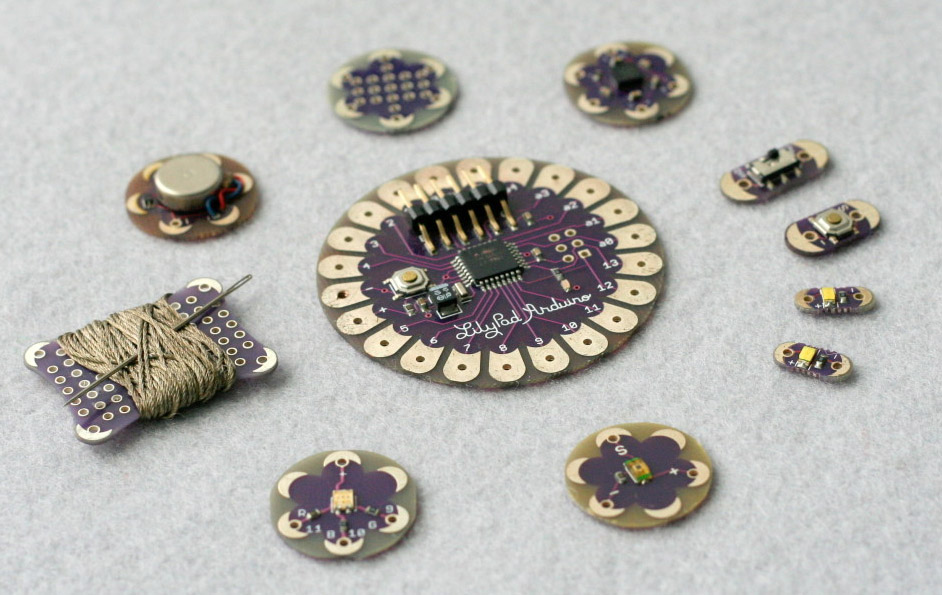by Mike Telin

When I read further I encountered such terms as Maker Movement, STEM (science, technology, engineering, and mathematics), and STEAM (science, technology, engineering, the arts, and mathematics).
My initial reaction was, I know a little bit about most of this, but not a lot about any of it. But after reading session descriptions and presenter bios, I was hooked. I needed to know more.
Last week I attended two sessions. “Crafting the Hybrid Body,” led by Cindy Kao from Cornell’s Hybrid Body Lab, was a fascinating lecture about wearable technology, and the four presenters in the “Lightning Lunchtime Panel” all had inspirational stories to share. Hearing Sara Trail talk about how she uses sewing and quilting to engage young people though the Social Justice Sewing Academy was enlightening. Crafting Change continues through June 19.
I spoke to Symposium director Abby Aresty, technical director and lecturer in Oberlin’s Technology In Music And Related Arts program (TIMARA), to learn more about the world of Making.
I began our Zoom conversation by asking her how she would describe the Symposium and its title during a short elevator ride.

There have been a lot of “crafting” titles lately. In the fall of 2019 the TIMARA department hosted a Crafting Sound Symposium and last fall I taught a class called Crafting Change: Art Activism in the 2020 Election. And I’ve been interested in embedding traditional handicrafts into sonic art practices and thinking about how that can “craft change” in the field that I’m in, which is music technology.
I hope this is not too much “inside baseball” for folks, but if they are drawn in, even for a moment, it will start to make sense.
Mike Telin: Does the Maker Movement work in tandem with the academic disciplines that are part of STEM and STEAM?
AA: Absolutely. There are so many people who have been working to create that connection. One of the most famous is Leah Buechley, who created the LilyPad Arduino, which is all about making a way to interface with sewing and technology. But a lot of her research has been about answering the question, how do we bring the Maker Movement to a broader audience?
MT: When did the Maker Movement begin to blossom?

MT: How did you become interested in it?
AA: My background is music composition — Eastman, University of Michigan, and University of Washington — and every time I was introduced to a technology, I was excited by what it afforded. At Eastman that was recording sound and working with physical objects to create sound.
At the University of Washington I took a mechatronics class where I learned a little bit of code and electronics. But my dissertation was about putting sound into an arboretum — a physical space. It was incredibly empowering to be able to walk through that space with the general public — I was like, wow, I can actually use technology to reach a different audience.
Since I’ve been at Oberlin, I’ve become more interested in the Maker Movement, which is how I came to collaborate with people at Lorain County Community College in their incredible FAB Lab. And that’s how I came to create with Kyle Hartzell for the Crafting Sound Symposium, where suddenly all these artists came and shared workshops and presentations that opened the door for me and many of my students to an even broader range of technologies and crafts.

AA: Honestly, my computer is probably my least favorite technology, but what is so appealing to me about these technologies is that they really are in the physical world. I love the imperfection of working with DIY, low-fi electronics and the sounds they are generating. I love experimenting and coming up with sonic results that I don’t expect — I think that’s beautiful. The imperfection is what makes it so exciting.
There is a growing interest in experimentation, and working with hybrid technologies brings up that energy, enthusiasm, and creativity. And the uncertainty about whether something is going to work.
MT: As an educator, what do you hope students will take away from their studies?
AA: There are so many things, I could talk your ear off for hours. But I work with many different types of students — college students, and younger students alongside college students in the Girls Electronic Arts Retreat (GEAR), a summer camp for third- to fifth-grade girls.

For me, that’s what this symposium is about — seeing what all of these artists and educators have done, and bringing these different worlds together.
Published on ClevelandClassical.com June 2, 2021.
Click here for a printable copy of this article




